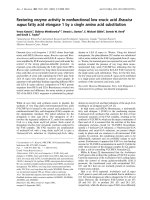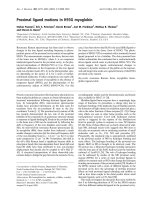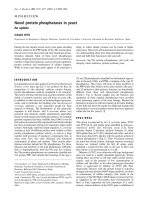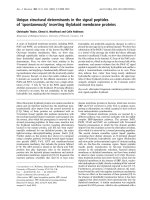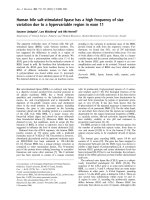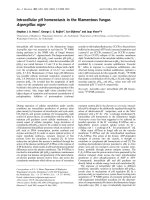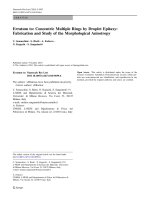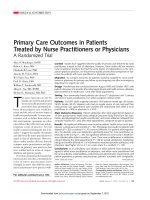Báo cáo y học: "Estimated intelligence quotient in anorexia nervosa: a systematic review and meta-analysis of the literature" pot
Bạn đang xem bản rút gọn của tài liệu. Xem và tải ngay bản đầy đủ của tài liệu tại đây (338.14 KB, 10 trang )
REVIE W Open Access
Estimated intelligence quotient in anorexia
nervosa: a systematic review and meta-analysis of
the literature
Carolina Lopez
1,2
, Daniel Stahl
1
, Kate Tchanturia
1*
Abstract
Background: It has been hypothesised that people with anorexia nervosa have a higher intelligence quotient (IQ)
level than the general population. The purpose of this review was to systematically appraise the research into
reported IQ levels in people with anorexia nervosa.
Methods: A search using the terms intelligence quotient, IQ, intelligence, cognition, eating disorders and anorexia
was conducted in electronic dat abases only.
Results: In all, 30 peer-reviewed studies written in English that used well established measures of intelligence
quotient (the National Adult Reading Test and Wechsler Intelligence Scales) were identified. This review established
that people with anorexia nervosa score 10.8 units and 5.9 units above the average intelligence quotient of the
normative population on the National Adult Reading Test and Wechsler Intelligence Scales, respectively. An
association was found between Body Mass Index and intelligence quotient, as measured by the National Adult
Reading Test.
Conclusions: More studies including other eating disorder categories and recovered people are needed to explore
important questions regarding the role of the intelligence quotient in treatment response.
Introduction
Eating disorders (EDs) are a g roup of ps ychiatric disor-
ders with a lifelong course and considerable morbidity
and mortality. In the Diagnostic and Statistical Manual
of Mental Disorders, fourth edition (DSM-IV), EDs
include anorexia n ervosa (AN), bulimia nervosa (BN),
and eating disorders not otherwise specified (EDNOS).
The aetiology of EDs remains unknown.
There has been increasing interest in the study of the
neuropsychological functioning of p eople with EDs for
the last three decades. One of the reasons for this is to
gain a better understanding of the aetiology and mainte-
nance of these disorders and to explore ways of improv-
ing available treatments [1].
Although t here are more than 100 papers on n europ-
sychology and brain imaging in EDs, in previous sys-
tematic reviews conducted by Roberts et al. [2] and
Lopez et al. [3] on set shifting and central coherence in
EDs, it was demonstrated that there are a limited num-
ber of neuropsychological studies on BN and those
recovered from the disorder. Most studies have explored
neuropsychological functioning in AN. Because there is
more available research in neuropsychology in AN, the
present systematic review focused on AN only.
AN is the most severe ED affecting mainly, but not
only, young women, and has the highest rate of mortality
linked to a psychiatric disorder, due to high levels of
medical complications and suicide in chronic patients [4].
Currently, psychological therapy is the main therapeu-
tic intervention recommended for the treatment of AN
(see, for example, [5]). Howev er, outcomes are far from
sati sfactory with only 50% of cases reaching recovery in
adult populations [4,6]. It is possible that factors such
as cognitive functioning, usually limited during the
acute phase of AN [7], influence treatment utilisation
and outcome. For instance, most available therapies
require the patient to have some level of insight and
* Correspondence:
1
Institute of Psychiatry, Kings College London, London, UK
Full list of author information is available at the end of the article
Lopez et al. Annals of General Psychiatry 2010, 9:40
/>© 2010 Lopez et al; licensee BioMed Central L td. This is an Open Access article distributed under the terms of the Creative C ommons
Attribution License ( which permits unrestricted use, distribution, and reprodu ction in
any medium, provided the original work is properly cited.
verbal ability; factors that might be related to optimal
intellectual level [8].
The intelligence quotient (IQ) represents a composite
scoreonavarietyoftestsdesignedtomeasurea
hypothesised general ability or intelligence [9]. It has
been hypothesised that people with AN have a higher
IQ level than the general population based on clinical
and school performance obs ervations. There is a sugges-
tion, however, that higher perfectionism, but not higher
IQ, would explain the better performance at school in
this group [10,11].
As neuropsychological studies h ave become more
popular in AN, there are several studies that have
measured intelligence as part of their assessments.
However,therearealimitednumberofstudieslooking
specifically at IQ levels in people with AN. We were
not able to find any systematic review summarising
research on intelligence in AN. Therefore, the question
about IQ in AN remains unanswered. It is expected
that examining the available literature in this area
would be helpful in providing information about intel-
lectual functioning in AN, investigating how compar-
able neuropsychological studies from different
academic groups are in the context of IQ estimation,
helping to clarify what the most appropriate IQ mea-
sure would be for fut ure studies, and exploring any
association between severity of illness (measured by
Body Mass Index (BMI)) and IQ levels.
With these questions in mind, a systematic review of
the literature and meta-analysis with the available data
on IQ in AN were conducted to address the hypothesis
that people with AN sho w superior scores on well vali-
dated IQ tests in comparison with the average IQ of the
normative population (norm). This h ypothesis is based
on the common but conflicting assumption that high
intelligence is a trait among people with AN [12,13].
We have also predicted that people with a past history
of AN, now recovered, would demonstrate higher IQ
scores than those who are in the acute phase of AN and
the normative population. We based this hypothesis on
thefactthatitwasshownthatIQpredictstermination
from treatment; that is, patients with a higher IQ are
more likely to remain in psychological treatment [14].
Methods
Search procedure and data extraction
This review follo ws the Preferred Reporting Items for
Systematic reviews and Meta-Analyses (PRISMA) state-
ment for meta-analysis [15]. The following electronic
databases were used to identify relevant papers for
inclusion in this review: Medline, Embase, Psych Info
and ISI Web of Science. A first search was conducted in
September 2008 and subsequently updated in March
2009.
A broad search was first run on the literature using
the terms ‘intelligence quotient’, ‘IQ’, ‘intelligence’,
‘neuropsychological assessment’, ‘neuropsychology’,
‘cognition’,and‘eating disorders’ (including ‘anorexia’,
‘bulimi a’, ‘EDNOS’, ‘recovered anorexia’, ‘recovered buli-
mia’). After failing to obtain a substantial number of
studies in bulimia nervosa (BN) or recovered AN that
included estimated IQ data this search was narrowed to
studies that included samples with AN only.
In this manner, the search was conducted by two
independent researchers searching for published studies
on the basis of the following inclusion criteria:
• Participants. Studies including subjects diagnosed
with AN and a sample greater than 10 participants.
• IQ measures. Studies using well known measures
to estimate IQ. Specifically, studies including the
National Adult Reading Test (NART) and Wechsler
scales (Wechsler Adult Intelligence Scale (WAIS),
Wechsler Intelligence Scale for Children (WISC),
short version of the WAIS (Wechsler Abbreviated
Scale of Intelligence; WASI) and the German version
of WISC (Hamburg-Wechsler-Intelligenztest für
Kinder; HAWIK).
• Data. Studies reporting at least full scale IQ data.
• Language. Studies published in English.
Results from t hese searches were merged for higher
reliability. Following the initial identification of relevant
published articles, all cit ations were then obt ained.
Further relevant references cited in the retrieved papers
were pursued.
Instruments
The NART [16] is a word-reading test (50 short words
of irregular pronunciation)widelyusedinresearchand
clinical practice as an estimate of premorbid intel lectual
ability [17]. It has high construct validity as a measure
of general intelligence and high levels of inter-rater and
test-retest reliability.
The Wechsler Intelligence Scales provide a current
estimation of IQ in the adult (WAIS) and child (WISC)
versions. These scales are composed of comprehensive
intellectual batteries that alternate verbal with visual-
perceptual or construction (performance) tests as stan-
dard procedure. The full scale IQ test is broken down
into subscales comprising verbal (information, digit
span, vocabulary, arithmetic, comprehension, similari-
ties) and performance scales (picture completion, picture
arrangement, block design, object assembly and digit
symbol).
It has been shown that NART and WAIS performance
correlate strongly [18]. For instance, correlations
between the NART IQ estimates and the WAIS and
Lopez et al. Annals of General Psychiatry 2010, 9:40
/>Page 2 of 10
revised WAIS (WAIS-R) British version are in the range
of 0.72 [9].
In both measures, for every age group, a norm of 100
corresponds to the average and 15 to the standard
deviation. This permits direct comparison between indi-
vidual scores with the normative data from the same
age range.
Data synthesis
Meta-analyses were carried out using Stata V. 9.1 (Stata,
College Station, TX, USA) using the user-contributed
commands for meta-analyses: ‘metan’ [19], ‘metainf’
[20], ‘metabias’ [21] and ‘metatrim’ [22].
In order to estimate whether the IQ of those suffering
from AN differs from the normative population, the
data provided by each study was compared with the
mean and SD from the normat ive population, known to
be a mean of 100 and standard deviation of 15 (Lezak
et al. [9]). The differences in mean IQ scores were stan-
dardised by dividing the difference of IQ of patients
with an eating disorder and the norm group by the stan-
dard deviation of the norm group [23], which is equiva-
lent to Cohen’sorGlass’s d. The standard error of the
effect size was calculated by
SE d
n
patient
()=
1
.
Because the mea n and the standard deviation of the
norm group are regarded as known (based on a large
sample size), a bias correction of the standard error is
not necessary. The effect siz es and standard errors of
the studies were then pooled using random-effect mod-
els, which allowed us to model possib le study-to-study
variation of effect sizes [24].
Meta-analyses were preformed separately for each of
the two instruments (NART and Wechsler’s derived
tests) using the user-contributed Stata command
‘metan’. The standardised effect sizes were also back
transformed into IQ score differences.
The results of the meta-analyses are reported as Forest
plots. Forest plots display the results of the meta-ana-
lyses in graphical format (see Figures 1 and 2). These
graphs represent the variation between the results of the
various studies and an estimate of the overall effect size
of all the studies together considering the data available
for each study included in the meta-analysis [25]. Each
line of t he Forest plot represents an individual study/
comparison. The position of the square in relation to
the vertical axis represents the point estimate of the
results of a particular study; specifically it shows how
the effect size of the study varies from zero. The size of
the square shows the weighed individual contribution
of the study to the meta-analysis and it is proportional
tothesamplesizeofthestudy.Thehorizontalline
through the square represents the 95% confidence
interval (CI) of the effect size. The overall estimate from
the meta-analysis and its CI are displayed at the bottom
of the plot, represented as a diamond.
Homogeneity between the trials was analysed using
Cochran’s Q test. Due to the small sample sizes, an
additional measure of heterogeneity or inconsistency I
2
(Q-(df)/Q) was calculated [26]. I
2
describes the percen-
tage of total variation across studies that is due to het-
erogeneity rather than chance and ranges between 0%
(no inconsistency) and 100% (high heterogeneity), with
values of 25%, 50% and 75% su ggested as low, moderate
and high heterogeneity [26].
The analyses were repeated excluding one study at a
time to investigate the influence of each individual study
on the overall meta-analysis summary using Stata’s user-
written function ‘metainf’.
Effect size
5
0
.5
1
1.5
2
Study
Effect size
(95% CI)
% Weight
Thompson, 1993
1.05 ( 0.43, 1.67)
5.0
Kingston, 1996
0.59 ( 0.30, 0.88)
8.5
Mathias, 1998
-0.26 (-0.60, 0.08)
8.0
Seed, 2000
0.77 ( 0.30, 1.23)
6.5
Tchanturia, 2004a
0.76 ( 0.42, 1.10)
8.0
Tchanturia, 2004b
0.74 ( 0.40, 1.08)
8.0
Key, 2006
0.60 ( 0.01, 1.19)
5.3
Fowler, 2006
0.55 ( 0.16, 0.95)
7.3
Tchanturia, 2007
1.01 ( 0.65, 1.38)
7.6
Bosanac, 2007
0.60 ( 0.11, 1.09)
6.2
Lopez, 2008
0.85 ( 0.53, 1.18)
8.1
Southgate, 2008
1.12 ( 0.68, 1.56)
6.8
Dickson, 2008
0.97 ( 0.57, 1.37)
7.2
Tchanturia, 2008
0.85 ( 0.47, 1.22)
7.5
Overall
0.72 ( 0.53, 0.91)
100.0
Figure 1 Forest plot for intelligence quotient (IQ) studies using
the National Adult Reading Test (NART): standardised effects
for patients with eating disorders (EDs) relative to the
normative population (norm) group.
Effect size
-1 5 0 .5 1 1.5 2
Study
Effect size
(95% CI) % Weigh
t
Wilbur, 1981 0.73 ( 0.40, 1.07) 6.8
Small, 1982
0.54 ( 0.16, 0.92) 6.5
Gordon, 1984
0.85 ( 0.23, 1.47) 4.9
Dura, 1989
0.17 (-0.27, 0.60) 6.1
Pendleton-Jones, 1991
0.29 (-0.06, 0.65) 6.7
Ranseen, 1992
-0.03 (-0.35, 0.28) 6.9
Mathias, 1998
-0.18 (-0.52, 0.16) 6.8
Grunwald, 2001
1.01 ( 0.39, 1.63) 4.9
Grunwald, 2002
0.90 ( 0.41, 1.39) 5.7
Bayless, 2002
0.24 (-0.02, 0.50) 7.3
Mcdowell, 2003
-0.12 (-0.32, 0.08) 7.6
Galderisi, 2003
0.00 (-0.52, 0.52) 5.5
Holliday, 2005
0.75 ( 0.47, 1.04) 7.1
Connan, 2006 1.17 ( 0.68, 1.66) 5.7
Steinglass, 2006
0.65 ( 0.15, 1.16) 5.6
McCormick, 2008
-0.23 (-0.72, 0.26) 5.7
Overall
0.40 ( 0.18, 0.61) 100.0
Figure 2 Forest plot for intelligence quotient (IQ) studies using
Wechsler’s tests: standardised effects for patients with eating
disorders (EDs) relative to the normative population (norm)
group.
Lopez et al. Annals of General Psychiatry 2010, 9:40
/>Page 3 of 10
Statistically significant results are more likely to be
published than studies wit h non-significant results.
Therefore, the presence of publication bias was assessed
informally by visual inspections of funnel plots, which
represent a plot of a study’s precision (1/standard error)
against effect size. The absence of studies in the right
bottom corner (low precision and small effect sizes) of a
funnel plot is usually taken as an indication of publica-
tion bias. The visual assessments were corroborated by
its corresponding statistical analogue, Begg’sadjusted
rank test [ 27], and additionally by Egger’s test [28], as
implemented in ‘metabias’.
We also used the Duval and Tweedie [29] non-para-
metric ‘trim and fill’ method of accounting for publica-
tion bias in meta-analysis as implemented in Stata’s
user-written command ‘metatrim ’ [30]. If the conclusion
of the meta-analysis remains unchanged following
adjustment for the publication bias using the trim and
fill method, the results can be considered as robust,
excluding publication bias.
Results
After careful assessment on a case-by-cas e basis, 30 stu-
dies (including 849 AN patients in total) were found
using the above-mentioned criteria. All of the identified
articles used eithe r the NART (N = 14) or Wechsler’s
derived tests (WAIS, WISC, short forms of WAIS and
HAWIK tests) (N = 16).
Sources of participants
All the selected studies used IQ test on people with AN
or recovered. In most studies participants came from
clinical populations (N = 28). In all, 14 studies involved
only participants who were inpatients at the time of the
study, 2 involved outpatients only, 8 involved both inpa-
tients and outpatients, 4 included community samples
apart from inpatients and outpatients and 1 study stated
that their sample came from a volunteer database only
[31]. One study did not specify the source of their
participants.
Table 1 shows details of the studies included in this
review. All the estimated IQ data is summarised in the
meta-analyses described below.
Estimated IQ in AN as measured by the NART
The NART was used in 14 studies, with a total sample
size of 365 AN patients. The sample size of the trials
ranged between 10 and 46. The mean IQ of the 14 stu-
dies ranged from 96.1 to 116.8. A meta-analysis using a
random effects model revealed an esti mate of the mean
standardised mean difference (SMD) of 0.72 with a 95%
confidence interval of 0.53 and 0.91.
The SMD of 0.72 means that patients with EDs score
on average 10.8 units (95% CI 7.9 to 13.6) above the
average IQ of the normativ e population. There was
evidence of considerable heterogeneity across studies
(Cochran’sQtest:X
2
(13)
= 43.7, p < 0.001 and I
2
=
70.2%). This variance was particularly due to the data
from Mathias and Kent [32] . In this study, the AN
group obtained lower IQ compared with norms, with an
effect size of d = -0.26 (see Figure 1). To investigate the
influence of t his study on the overall meta-analysis, t he
meta-analysis was repeated excluding one study at a
time to ensure that the results were not biased by a sin-
gle outlier. Rerunning the analysis without the Mathias
and Kent study [32] increased the SMD slightly from
0.72 to 0.79 (95% CI 0.68 to 0.90). There was no more
evidence for heterogeneity between studies (Cochran’s
Qtest:X
2
(12)
= 9.58, p = 0.65, I
2
= 0%). T he influence
of other studies on the overall estimate was minor (see
Figure 3).
Publication bias
A funnel plot based on all 14 studies did not indicate
publication bias either with or without Mathias and
Kent [32], nor did formal tests (Begg’stestz =0.47,p =
0.64 and Egger’s test t = 0.86, p = 0.40 and Begg’stestz
= 0.63, p =0.53andEgger’stestt=0.69,p = 0.50,
respectively). The trim and f ill method did not indicate
missing studies.
In summary, there is no evidence for publication bias
and the estimated effect size found from the random
effects model is realistic. The overall conclusion from
this analysis is that people with AN tend to consiste ntly
score higher than population norms on the NART
across published studies.
IQ in AN as measured by Wechsler’s tests
Wechsler’s tests were used in 16 studies with a total
sample size of 484 patients. The WAIS was used in five
studies, WAIS-R in six studies, the short form of the
WAIS (WASI) in one study, two studies used both t he
WAIS and the WISC according to the age of partici-
pants and two studies used HAWIK (the German ver-
sionofWAIS).Thesamplesizeofthetrialsranged
between 10 and 98. Th e mean IQ of the 16 studies ran-
ged from 96.5 to 117.6. Using a ra ndom effects meta-
analysis, the estimate of the pooled SMD was a small to
medium effect size of d = 0.40 (95% CI 0.18 to 0.61)
across all studies. The SMD of 0.40 translates that
patients with EDs score on average 5.9 units (95% CI
2.7 to 9.2) above the average IQ of the normative
population.
The meta-analysis (see Figure 2) revealed a high
degree of heterogeneity across the stud ies (X
2
(15)
= 81.2,
p < 0.001), with an index of inconsistency of 81.5%;
parameters that justified the use of a random effects
model. The heterogeneity was not due to a single study,
Lopez et al. Annals of General Psychiatry 2010, 9:40
/>Page 4 of 10
as when the meta-analysis was re-estimated omitting
each study in turn, no single study had a significant
influence on the results. About half of the included stu-
dies showed a moderate to high effect size, whereas the
remaining showed little or no mean effect, which may
explain this heterogeneity. This observation will be dis-
cussed later in this section.
The analyses were repeated excluding one study at a
time to investigate the influence of each individual study
on the overall meta-analysis summary.
The influence of individual studies on the estimated
overall effect size (removing each study and recalculat-
ing overall effect) was minor. Rerunning the meta-analy-
sis excluding one study at a time resulted only in minor
differences of the estimated SMDs (range of d =0.35to
0.44; see Figure 4).
Publication bias
From the Forest plot (Figure 2), it could be assumed
that there are two types of studies: those with an ES
around 0 (no differences between the IQ of those with
AN and norms) and those with an ES around 0.75
(moderate to high differences between populations).
This, alongside the fact that the funnel plot based on all
16 studies is s lightly asymmetrical, would suggest some
publication bias towards studies with l arger effect sizes.
This was confirmed by Egger’s test (Egger’s test t = 2.11,
p = 0.05, Begg’stestz =1.09,p =0.27).However,the
trim and fill method did not estimate any missing study,
which suggests that the results a re robust (Figure 5).
Also, studies with an ES around 0 or 0.75 seem not to
be different in terms of the year of the study, the num-
ber, age or BMI of participants, comorbidity, or whether
Table 1 Studies included in this review
Lead authors Publication date and reference IQ test N Age BMI IQ mean IQ SD
NART studies:
Kingston 1996 [41] NART 46 22.1 14.7 108.9 5.7
Mathias 1998 [32] NART-R 34 22 15.3 96.1 8.8
Seed 2000 [42] NART 18 27.3 15.2 111.5 9.4
Tchanturia 2004 [43] NART-R 34 26.7 13.7 111.4 6.5
Tchanturia 2004 [37] NART-R 34 27.2 13.7 111.1 7
Fowler 2006 [44] NART 25 16.9 15.3 108.3 5.5
Tchanturia 2007 [36] NART 29 28.5 15.5 115.2 5.5
Bosanac 2007 [35] NART 16 28.9 15.2 109 8.6
Lopez 2008 [45] NART 37 28.4 15.8 112.8 6.8
Southgate 2008 [46] NART 20 26.8 16.3 116.8 4.8
Dickson 2008 [31] NART 24 30.6 16 114.5 5
Tchanturia 2008 [47] NART 27 28.8 14.3 112.7 6.5
Key 2006 [48] NART 11 27.65 16.8 109 11.1
Thompson 1993 [49] NART 10 25.8 115.8 NR
WAIS studies:
Pendleton-Jones 1991 [38] WAIS 30 24.4 59% ideal 104.4 12.6
Mathias 1998 [32] WAIS-R 34 22 15.3 97.3 16.3
Galderisi 2003 [50] WAIS 14 Approximately 23.7 15.4 100 10.8
Holliday 2005 [51] WAIS-R 47 26.3 17.9 111.3 7.6
Connan 2006 [52] WAIS-R 16 25.4 16.2 117.6 16.7
Steinglass 2006 [53] WASI 15 25.6 19 109.8 12.1
McCormick 2008 [54] WAIS 16 Approximately 25.2 NR 96.5 12.9
Dura 1989 [10] WAIS-R 20 14.7 NR 102.5 NR
McDowell 2003 [55] WAIS-R 98 27.2 15.9 98.2 12.1
Grunwald 2001 [56,57] HAWIK 10 15.9 15.2 115.2 8
Gordon 1984 [58] WAIS and WISC-R 10 15.7 NR 112.7 13.1
Grunwald 2002 [59] HAWIK 16 15.3 14.8 113.5 12.4
Bayless 2002 [60] WAIS 59 24.3 16.8 103.6 12.1
Wilbur 1981 [61] WAIS/WISC 34 17 NR 111 NR
Ranseen 1992 [62] WAIS-R 38 21.7 NR 99.5 16.6
Small 1982 [63] WAIS 27 20.6 NR 108.1 10.4
BMI = Body Mass Index; HAWIK = Hamburg-Wechsler-Intelligenztest für Kinder (German version of WAIS); NART(-R) = National Adult Reading Test (Revised); NR =
not reported; SD = standard deviation; WAIS(-R) = Wechsler Adult Intelligence Scale (Revised); WASI = Wechsler Abbreviated Scale of Int elligence (short form of
WAIS); WISC(-R) = Wechsler Children Intelligence Scale (Revised).
Lopez et al. Annals of General Psychiatry 2010, 9:40
/>Page 5 of 10
participants were in/outpatients. Therefore, the results
suggest the absence of an identifiable publication bias.
IQ and BMI
BMI data available from the studies included in this
review were correlated with the estimated IQ obtained
from studies in order to understand the role of nutri-
tional status in the intellectual functioning of people
with AN.
Firstly, a correlation analysis was run between BMI
and IQ with all data available (fro m NART or Wesch-
ler’s scales). The results did not show a correlation
between these two variables. However, when separating
studies according to the instrument used to estimate IQ
(Weschler’s scales or NART), a trend for a significant
moderate correlation was found in those studies using
the NART (Spearman coefficient = 0.56, p =0.07),
meaning that taking all these studies as a group, lower
premorbid IQ was associated with lower BMI. No corre-
lation was found between IQ estimated by Weschler’s
scales and BMI, suggesting that current IQ does not
fluctuate with changes in BMI.
IQ and recovery
We were able to identify only four studies including
women with past history of AN now recovered (N = 64,
see Table 2). Three of these studies used the NART and
the revised NART (NART-R) and only one study used
the WAIS. The small number of studies did not allow a
formal random effect meta-analysis . However, in all four
studies, patients scored significantly more than 100, as
the 95% confidence intervals show (Table 2).
A descriptive comparison of these results suggests that
those recovered from AN s core higher on IQ measures
(mean IQ ranged from 109.3 t o 118.1) than groups with
current AN (mean IQ in current AN ranged from 96.1
to 116.8 and 96.5 to 117.6 using the NART and WAIS,
respectively) and norms. Along the same lines as the
conclus ion above, this very prelim inary result may indi-
cate that those who recover tend to have higher premor-
bid IQ. More research in recovered samples is needed in
order to clarify this observation.
Discussion
The aim of this study was to provide a comprehensive
systematic review of the literature including a meta-ana-
lysis for estimated IQ data in AN compared with the
average IQ obtained from normative data. Studies
included in this review were selected on the basis of
quality of the data and validity of instruments used to
0.49
0.72
0.53
0.91
0.94
Thompson, 1993
Kingston, 1996
Mathias, 1998
Seed, 2000
Tchanturia, 2004a
Tchanturia, 2004b
Key, 006
Fowler, 2006
Tchanturia, 2007
Bosanac , 2007
Lopez, 2008
Southgate, 2008
Dickson, 2008
Tchanturia, 2008
Study ommited
Meta-analysis random-effects
Figure 3 Results of an influence analysis in which the meta-
analysis is re-estimated omitting each study in turn. Rerunning
the analysis without the study by Mathias and Kent [32] increased
the standardised mean difference (SMD) from 0.72 to 0.79 (95% CI
0.68 to 0.90). The straight vertical lines at 0.72, 0.53 and 0.91
represent the SMD and upper and lower 95% confidence intervals
of the complete study analysis.
0.14 0.40 0.18 0.61 0.6
6
Wilbur, 1981
Small, 1982
Gordon, 1984
Dura, 1989
Pendleton-Jones, 1991
Ranseen, 1992
Mathias, 1998
Grunwald, 2001
Grunwald, 2002
Bayless, 2002
Mcdowell, 2003
Galderisi, 2003
Holliday, 2005
Connan, 2006
Steinglass, 2006
McCormick, 2008
Study ommited
Meta-analysis random-e
ff
ects estimates
(
linear
f
orm
)
Figure 4 Results of an influence analysis in which the meta-
analysis is re-estimated omitting each study in turn. The
straight vertical lines at 0.40, 0.18 and 0.61 represent the estimated
standardised mean difference (SMD) and upper and lower 95%
confidence intervals of the complete study analysis.
Figure 5 Begg’s funnel plot with pseudo-95% confidence limits
for meta-analysis based on Wechsler studies.
Lopez et al. Annals of General Psychiatry 2010, 9:40
/>Page 6 of 10
estimate intellectual ability. Thus, NART and Wesch ler’s
scales were selected as the most common and reliable
measures.
It was established that most people with AN have
higher average IQ scores compared with the average of
normative data. Specifically, studies using the NART
consist ently showed a higher IQ in AN patients in com-
parison with established norms.However,thoseusing
Wechsler’s scales obtained more heterogeneous results,
with half of the studies showing moderate to high effect
sizes (average ES = 0.75) and half of them with low or
negligible effect sizes (average ES around 0). Examina-
tion of the characteristics of the various studies (for
example, age at testing, BMI, reported c omorbid condi-
tions, and so o n) was not able to explain this heteroge-
neity. These results overall show that people with AN
have at least as high IQ as norms, which indicates a dif-
ference, compared to other psychiatric conditions.
There are two points that are worth highlighting in
this discussion about the heterogeneity of results.
Although the WAIS and NART are highly correlated,
the NART estimates premorbid IQ and Wechsler’ s
scales measure current ability. Predictions could be
made from NART scores about performance, verbal and
total IQ based predominantly on verbal a bilities, which
are thought to be generally preserved in AN [1,7],
whereas Weschler’s scales assess mixed verbal, perfor-
mance and visual spatial abilities. The latter have been
reported to be more impaired in people with acute AN
(see, for example, [7]). It might be possible that those
studies using Wechsler’s scales with lower effect sizes
are demonstr ating differences in the performance of the
samples that are not evident in full scale IQ data (for
example, differences in performance versus verbal IQ or
lower scores in scales involving visual spatial abilities).
We are not able to clarify this point with this review, as
most studies provided full scale IQ only, as previously
mentioned. Also, Wechsler’sscalesusedinthestudies
included in this review are composed of different scales
(for example, WAIS, WISC, short version, and so on)
and there was no consistent use of one single
instrument.
Both premorbid and current IQ yield valid and inter-
esting information for future studies and the m easure
selected will depend on the nature and objectives of
future studies. Therefore, it seems that simple and
reliable measures such as the NAR T provide more con-
sistent data on IQ, without the bias that a nomalies in
cognitive performance (typically present in the acute
phase of AN) may introduce in test performance. Also,
from the available literature, it is still hard to draw firm
conclusions regarding performance and verbal IQ. Clear
reporting in future studies (for example, separating ver-
bal from performance IQ) will help to address this
point.
A coordinated approach and consensus of IQ mea-
sures in the field will make data more comparable and
will prov ide better insight into the relationship between
illness severity and the n europsychological profile of
AN. For example, meta-analyses and systematic reviews
conducted in schizophrenia allowed researchers to iden-
tify that, before the onset of psychosis, IQ scores are
approximately 0.5 standard deviations below that of
healthy comparison subjects, and low IQ could be con-
sidered as one of t he risk factors for schizophrenia
[33,34].
In order to explore the question about the potential
contribution of IQ as a predictor of recovery, we made
an attempt to review studies on recovered AN popula-
tions. Only four studies [35-38] reported IQ data on
women with a past histo ry of AN. We did not have effi-
cient power to draw strong conclusions f rom the avail-
able studies. However, a meta-analysis showed that
people who had recovered from the illness had higher
IQ in comparison to norms and studies on acute AN
groups, included in this paper. There is a growing litera-
ture suggesting that IQ level can predict treatm ent out-
come in psychiatric conditions such as schizophrenia
and autism (see, for example, [39]). We predict that this
line of research will also be highly informative for the
ED field. For example, it was reported that higher IQ
predicts completion of psychological treatment in early
studies [14]. To our knowledge, none of the treatment
studies conducted in EDs looked at drop-out data in the
context of IQ. In general, it is clear that all treatment
studies in AN have high drop-out rates [40]. From the
results of this study, it seems likely that successfully
treated patients with AN have higher premorbid IQ,
which would support the hypothesis of the higher the
IQ, the better the treatment prognosis. However, more
Table 2 Studies in recovered anorexia nervosa samples
Lead author Publication date and reference IQ test N IQ mean (95% CI) IQ SD
Tchanturia 2004 [37] NART-R 18 113.6 (109.1 to 118.1) 9.1
Tchanturia 2007 [36] NART 14 118.1 (114.8 to 121.4) 5.7
Bosanac 2007 [35] NART 12 114.5 (110.9 to 118.1) 5.7
Pendleton-Jones 1991 [38] WAIS 20 109.3 (102.0 to 116.6) 15.5
SD = standard deviation.
Lopez et al. Annals of General Psychiatry 2010, 9:40
/>Page 7 of 10
studies will be needed to confirm this prediction and
which other factors may be involved (for example, envir-
onmental, physiological, and so on).
We believe that this systematic apprai sal of the litera-
ture was helpful in highlighting a trend that suggests
that people with AN have average or higher than a ver-
age IQ (in both NART and WAIS studies). The benefit
of this appraisal of current knowledge will help
researchers in planning future studies and formulate
important questions, such as: do patients with higher IQ
have better prognosis? How could high IQ be effectively
used in psychological treatment? Is IQ decline evident
in AN? Whereas the most obvious reason will be mal-
nutrition, none of the studies so far have used premor-
bid and current IQ measures simultaneously.
Finally, this study helped us to reflect on the fact that
comparison clinical groups should be carefully selected
in future studies on AN, because IQ will be an impor-
tant contributing factor in social cognition, cogni-
tive tasks, either using self-report or experimental
instruments.
This review has some limitations. Firstly, one of the
limitations is the retrospective nature of the data. Sec-
ondly, results in studies using Wechsler’s scales showed
high heterogeneity, which makes it difficult to draw
strong conclusions from these scales. We examined the
influence of the use of different versions of the test as
well as different age groups and other clinical character-
istics of the samples. Despite efforts to clarify the rea-
sons behind such different results, we were not able to
identify a consistent fact or across studies. We have also
confirmed a lack of literature related to other ED diag-
nostic categories, such as BN, EDNOS or recovered ED
groups in the context of IQ. This fact precludes the pos-
sibility to generalise these results to other ED groups
and more importantly, the examination of potential rela-
tionships between IQ, recovery and prognosis. Thirdly,
it is important to mention that most of reviewed st udies
involved clinical participants (inpatients or outpatients)
or registered volunteers. One of the possibilities is that
these samples are highly selected because they are not
population-based samples, rather people who seek treat-
ment in the clinics or are willing to participate in
research. This may relate to highe r education and IQ
performance but these questions are beyond the scope
of this study. Finally, as the main outcome of most of
studies included in this review was not IQ performance,
it is likely that a publication bias exists, however i t is
not possible to address it in this study.
From this review some recommendations arise: the
majority of accessed studies used the NART or Wechs-
ler’s scales. It will be useful if future studies continue
to use these measures to make future data comparable.
It will also be desirable for all studies looking at
neuropsychological factor to include an IQ measure due
to the effect that it may have on neuropsychological
task performance. Finally, since neuropsychological
research is increasing, it will be helpful to report covari-
ate analysis in relation to IQ; for example, with treat-
ment outcomes, symptom severity and recovery.
Conclusions
This research highlights an important and underexa-
mined factor in AN. The m ain conclusion is that IQ in
AN is at least as high as the average IQ found in the
normative population and most studies show that t his
group have a high average IQ. There is a preliminary
but important observation about IQ in the recovered
population, which is that this group may represent a
group with higher IQ than norms and current AN
groups, opening the question about the influence of
this factor on treatment and recovery. We think that
exploring IQ in the context of treatment and recovery
may provide useful information for clinicians and
researchers.
Acknowledgements
This work is part of the ARIADNE (Applied Research into Anorexia Nervosa
and Not Otherwise Specified Eating Disorders) programme, funded by a
Department of Health NIHR Programme Grant for Applied Research
(reference number RP-PG-0606-1043). The views expressed in this
publication are those of the author(s) and not necessarily those of the NHS,
the NIHR or the Department of Health. The authors would like to thank Nils
Köthke for his assistance in the preparation of an early draft of the
manuscript.
Author details
1
Institute of Psychiatry, Kings College London, London, UK.
2
Faculty of
Medicine, University of Chile, Santiago, Chile.
Authors’ contributions
CL contributed to the design of the study, performed the main search, data
extraction, data synthesis, supported general analyses and interpretation of
data, and contributed to drafting the manuscript. DS contributed to the
design of the study, performed the statistical analyses, drafted the results
section and critically reviewed the manuscript. KT contributed to the design
of the study, did an independent search of the papers, supervision/
interpretation of data and drafted the main part of the manuscript. All
authors approved the final manuscript.
Competing interests
The authors declare that they have no competing interests.
Received: 20 July 2010 Accepted: 23 December 2010
Published: 23 December 2010
References
1. Tchanturia K, Campbell I, Morris R, Treasure J: Neuropsychological studies
in anorexia nervosa. Int J Eat Disord 2005, 35:1-15.
2. Roberts ME, Tchanturia K, Stahl D, Southgate L, Treasure J: A systematic
review and meta-analysis of set shifting ability in eating disorders.
Psychol Med 2007, 37:1075-1084.
3. Lopez C, Tchanturia K, Stahl D, Treasure J: Central coherence in eating
disorders: a systematic review. Psychol Med 2008, 38:1393-1404.
4. Lock JD, Fitzpatrick KK: Anorexia nervosa. Clin Evid 2009, 1:1-19.
5. National Institute for Clinical Excellence: National Clinical Practice Guideline:
Eating Disorders: Core interventions in the treatment and management of
Lopez et al. Annals of General Psychiatry 2010, 9:40
/>Page 8 of 10
anorexia nervosa, bulimia nervosa, and related eating disorders London, UK:
National Institute for Clinical Excellence; 2004.
6. Bulik CM, Berkman ND, Brownley KA, Sedway JA, Lohr KN: Anorexia
nervosa treatment: a systematic review of randomized controlled trials.
Int J Eat Disord 2007, 40:310-320.
7. Southgate L, Tchanturia K, Treasure J: Neuropsychological studies in
eating disorders: a review. Eating Disorders: New Research Hauppauge, NY,
USA: Nova Science Publishers; 2006, 1-69.
8. Tchanturia K, Hambrook D: Cognitive remediation therapy for anorexia
nervosa. Treatment of Eating Disorders New York, USA: Guilford Press; 2009,
130-150.
9. Lezak M: Neuropsychological Assessment Oxford, UK: Oxford University Press;
2007.
10. Dura JR, Bornstein RA: Differences between IQ and school achievement
in anorexia nervosa. J Clin Psychol 1989, 45:433-435.
11. Blanz BJ, Detzner U, Lay B, Rose F, Schmidt MH: The intellectual
functioning of adolescents with anorexia nervosa and bulimia nervosa.
Eur Child Adolesc Psychiatry 1997, 6:129-135.
12. Muñoz R, Amado H: Anorexia nervosa: an affective disorder. New Dir Ment
Health Serv 1986, 31:13-19.
13. Rajewska A, Talarczyk M: The estimation of the level of intelligence
quotient and aspirations in patients with anorexia nervosa. Eur Psychiatry
1996, 11:374s.
14. Hiler EW: Wechsler-Bellevue Intelligence: a predictor of continuation in
psychotherapy. J Clin Psychol 1958, 14:192-194.
15. Liberati A, Altman DG, Tetzlaff J, Mulrow C, Gøtzsche PC, Ioannidis JP,
Clarke M, Devereaux PJ, Kleijnen J, Moher D: The PRISMA statement for
reporting systematic reviews and meta-analyses of studies that evaluate
health care interventions: explanation and elaboration. PLoS Med 2009, 6:
e1000100.
16. Nelson HE: National Adult Reading Test (NART): Test Manual Windsor: UK:
NFER-NELSON Publishing Co; 1982.
17. Crawford JR, Deary IJ, Starr J, Whalley LJ: The NART as an index of prior
intellectual functioning: retrospective validity study covering 66-year
interval. Psychol Med 2001, 31:451-458.
18. Schretlen DJ, Buffington AL, Meyer SM, Pearlson GD: The use of word-
reading to estimate “premorbid” ability in cognitive domains other than
intelligence. J Int Neuropsych Soc 2005, 11:784-787.
19. Bradburn MJ, Deeks JJ, Altman DG: sbe24: metan - an alternative meta-
analysis command. Stata Tech Bull 1998, 44:1-15.
20. Tobias A: Assessing the influence of a single study in the meta-analysis
estimate. Stata Tech Bull 1999, 47:15-17.
21. Steichen T: sbe19: tests for publication bias in meta-analysis. Stata Tech
Bull 1998, 41:9-15.
22. Steichen T: METATRIM: Stata module to perform nonparametric analysis of
publication bias, S410501 SSC Boston, MA, USA: Boston College Department
of Economics; 2000.
23. Thomas JD, Hersen M: Understanding research in Clinical and Counseling
Psychology Hillsdale, NJ: Lawrence Erlbaum Associates; 2003.
24. Everitt BS: Modern Medical Statistics London, UK: Arnold Publishers; 2003.
25. Lewis S, Clarke M: Forest plots: trying to see the wood and the trees. BMJ
2001, 322:1479-1480.
26. Higgins JPT, Thompson SG, Deeks JJ, Altman DG: Measuring inconsistency
in meta-analyses. BMJ 2003, 327:557-560.
27. Begg CB, Mazumdar M: Operating characteristics of a rank correlation
test for publication bias. Biometrics 1994, 50:1088-1101.
28. Egger M, Smith GD, Schneider M, Minder C: Bias in meta analysis detected
by a simple, graphical test. BMJ 1997, 315:629-634.
29. Duval S, Tweedie R: Trim and fill: a simple funnel-plot-based method of
testing and adjusting for publication bias in meta-analysis. Biometrics
2000, 56:455-463.
30. Steichen T: Nonparametric trim and fill analysis of publication bias in
meta-analysis. Stata Tech Bull 2001, 10:57.
31. Dickson H, Brooks S, Uher R, Tchanturia K, Treasure K, Campbell I: The
inability to ignore: distractibility in women with restricting anorexia
nervosa. Psychol Med 2008, 38:1741-1748.
32. Mathias J, Kent P: Neuropsychological consequences of extreme weight
loss and dietary restriction in patients with anorexia nervosa. J Clin Exp
Neuropsychol 1998, 20 :548-564.
33. Woodberry K, Giuliano A, Seidman L: Premorbid IQ in schizophrenia: a
meta-analytic review. Am J Psychiatry 2008, 165:579-587.
34. Reichenberg A, Weiser M, Rapp MA, Rabinowitz J, Caspi A, Schmeidler J,
Knobler HY, Lubin G, Nahon D, Harvey PD, Davidson M: Elaboration on
premorbid intellectual performance in schizophrenia: premorbid
intellectual decline and risk for schizophrenia. Arch Gen Psychiatry 2005,
62:1297-1304.
35. Bosanac P, Kurlender S, Stojanovska L, Hallam K, Norman T, McGrath C,
Burrows G, Wesnes K, Manktelow T, Olver J: Neuropsych ologi cal study
of underweight and “weight-recovered
” anorexia nervosa comp ared
with bulimia nervosa and normal controls . IntJEatDisord2007,
40:613-621.
36. Tchanturia K, Pei-Chi L, Uher R, Lawrence N, Treasure J, Campbell IC: An
investigation of decision making in anorexia nervosa using the Iowa
Gambling Task and skin conductance measurements. J Int Neuropsychol
Soc 2007, 13:635-641.
37. Tchanturia K, Morris R, Anderluh M, Collier D, Nikolaou V, Treasure J: Set
shifting in anorexia nervosa: an examination before and after weight
gain, in full recovery and relationship to childhood and adult OCPD
traits. J Psychiatr Res 2004, 38:545-552.
38. Pendleton Jones B, Duncan C, Brouwers P, Mirsky A: Cognition in eating
disorders. J Clin Exp Neuropsychol 1991, 13:711-728.
39. Howlin P, Magiati I, Charman T: Systematic review of early intensive
behavioral interventions for children with autism. Am J Intellect Dev
Disabil 2009, 114:23-41.
40. Halmi KA, Agras WS, Crow S, Mitchell J, Wilson GT, Bryson SW, Kraemer HC:
Predictors of treatment acceptance and completion in anorexia nervosa:
implications for future study designs. Arch Gen Psychiatry 2005,
62:776-781.
41. Kingston K, Szmukler G, Andrewes D, Tress B, Desmond P:
Neuropsychological and structural brain changes in anorexia nervosa
before and after refeeding. Psychol Med 1996, 26:15-28.
42. Seed J, Dixon R, McCluskey S, Young A: Basal activity of the
hypothalamic-pituitary-adrenal axis and cognitive function in anorexia
nervosa. Eur Arch Psychiatry Clin Neurosci 2000, 250:11-15.
43. Tchanturia K, Anderluh MB, Morris RG, Rabe-Hesketh S, Collier DA,
Sanchez P, Treasure JL: Cognitive flexibility in anorexia nervosa and
bulimia nervosa. J Int Neuropsychol Soc 2004, 10:513-520.
44. Fowler L, Blackwell A, Jaffa A, Palmer R, Robbins TW, Sahakian BJ,
Dowson JH: Profile of neurocognitive impairments associated with
female in-patients with anorexia nervosa. Psychol Med 2005, 36:517-527.
45. Lopez C, Tchanturia K, Stahl D, Booth R, Holliday J, Treasure J: An
examination of the concept of central coherence in women with
anorexia nervosa. Int J Eat Disord 2008, 41:143-152.
46. Southgate L, Tchanturia K, Treasure J: Information processing bias in
anorexia nervosa. Psychiatry Res 2008, 160:221-227.
47. Tchanturia K, Davies H, Lopez C, Schmidt U, Treasure J, Wykes T:
Neuropsychological task performance before and after cognitive
remediation in anorexia nervosa: a pilot case series. Psychol Med 2008,
38:1371-1373.
48. Key A, O’Brien A, Gordon I, Christie D, Lask B: Assessment of neurobiology
in adults with anorexia nervosa. Eur Eat Disord Rev
2006, 14:308-314.
49. Thompson S: Implications of neuropsychological test results of women
in a new phase of anorexia nervosa. Eur Eat Disord Rev 1993, 1:152-165.
50. Galderisi S, Mucci A, Monteleone P, Sorrentino D, Piegari G, Maj M:
Neurocognitive functioning in subjects with eating disorders: the
influence of neuroactive steroids. Biol Psychiatry 2003, 53:921-927.
51. Holliday J, Tchanturia K, Landau S, Collier DA, Treasure J: Is impaired set-
shifting an endophenotype of anorexia nervosa? Am J Psychiatry 2005,
162:2269-2275.
52. Connan F, Murphy F, Connor SE, Rich P, Murphy T, Bara-Carill N, Landau S,
Krljes S, Ng V, Williams S, Morris RG, Campbell IC, Treasure J: Hippocampal
volume and cognitive function in anorexia nervosa. Psychiatry Res 2006,
146:117-125.
53. Steinglass JE, Walsh T, Stern Y: Set shifting deficit in anorexia nervosa.
J Int Neuropsychol Soc 2006, 12:431-435.
54. McCormick LM, Keel PK, Brumm MC, Bowers W, Swayze V, Andersen A,
Andreasen N: Implications of starvation-induced change in right dorsal
anterior cingulate volume in anorexia nervosa. Int J Eat Disord 2008,
41:602-610.
55. McDowell , Moser , Ferneyhough K, Bowers W, Andersen A, Paulsen J:
Cognitive impairment in anorexia is not due to depressed mood. Int J
Eat Disord 2003, 33:351-355.
Lopez et al. Annals of General Psychiatry 2010, 9:40
/>Page 9 of 10
56. Grunwald M, Ettrich C, Assmann B, Dähne A, Krause W, Busse F, Gertz HJ:
Deficits in haptic perception and right parietal theta power changes in
patients with anorexia nervosa before and after weight gain. Int J Eat
Disord 2001, 29:417-428.
57. Grunwald M, Ettrich C, Krause W, Assmann B, Dähne A, Weiss T, Gertz HJ:
Haptic perception in anorexia nervosa before and after weight gain. J
Clin Exp Neuropsychol 2001, 23:520-529.
58. Gordon DP, Halmi KA, Ippolito PM: A comparison of the
neuropsychological evaluation of adolescents with anorexia nervosa and
of adolescents with conduct disorders. J Adolesc 1984, 7:245-266.
59. Grunwald M, Ettrich C, Busse F, Assmann B, Dähne A, Gertz H: Angle
paradigm: a new method to measure right parietal dysfunctions in
anorexia nervosa. Arch Clin Neuropsychol 2002, 17:485-496.
60. Bayless JD, Kanz JE, Moser DJ, McDowell BD, Bowers WA, Andersen AE,
Paulsen JS: Neuropsychological characteristics of patients in a hospital-
based eating disorder program. Ann Clin Psychiatry 2002, 14:203-207.
61. Wilbur C, Colligan R: Psychologic and behavioral correlates of anorexia
nervosa. J Dev Behav Pediatr 1981, 2:89-92.
62. Ranseen JD, Humphries LL: The intellectual functioning of eating
disorders patients. J Am Acad Child Adolesc Psychiatry 1992, 31 :844-846.
63. Small A, Teagno L, Madero J, Gross H, Ebert M: A comparison of anorexics
and schizophrenics on psychodiagnostic measures. Int J Eat Disord 1982,
1:49-56.
doi:10.1186/1744-859X-9-40
Cite this article as: Lopez et al.: Estimated intelligence quotient in
anorexia nervosa: a systematic review and meta-analysis of the
literature. Annals of General Psychiatry 2010 9:40.
Submit your next manuscript to BioMed Central
and take full advantage of:
• Convenient online submission
• Thorough peer review
• No space constraints or color figure charges
• Immediate publication on acceptance
• Inclusion in PubMed, CAS, Scopus and Google Scholar
• Research which is freely available for redistribution
Submit your manuscript at
www.biomedcentral.com/submit
Lopez et al. Annals of General Psychiatry 2010, 9:40
/>Page 10 of 10

